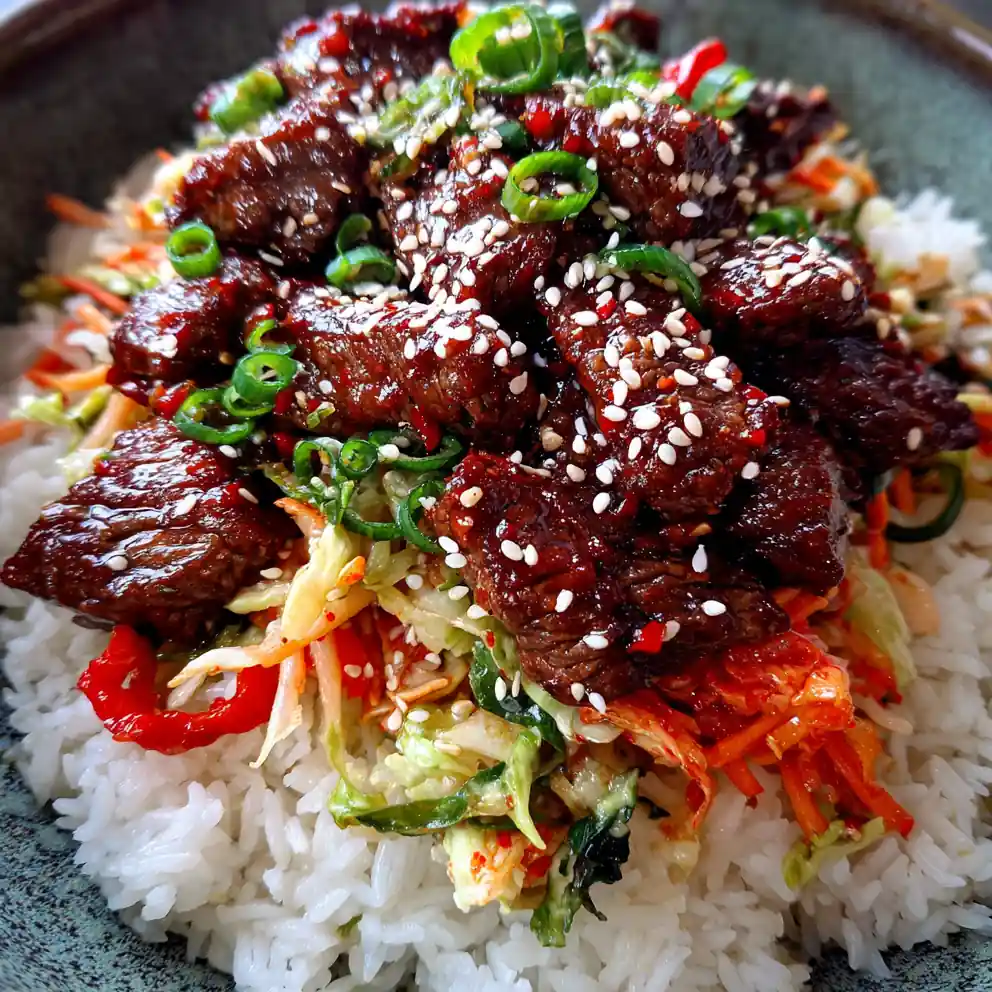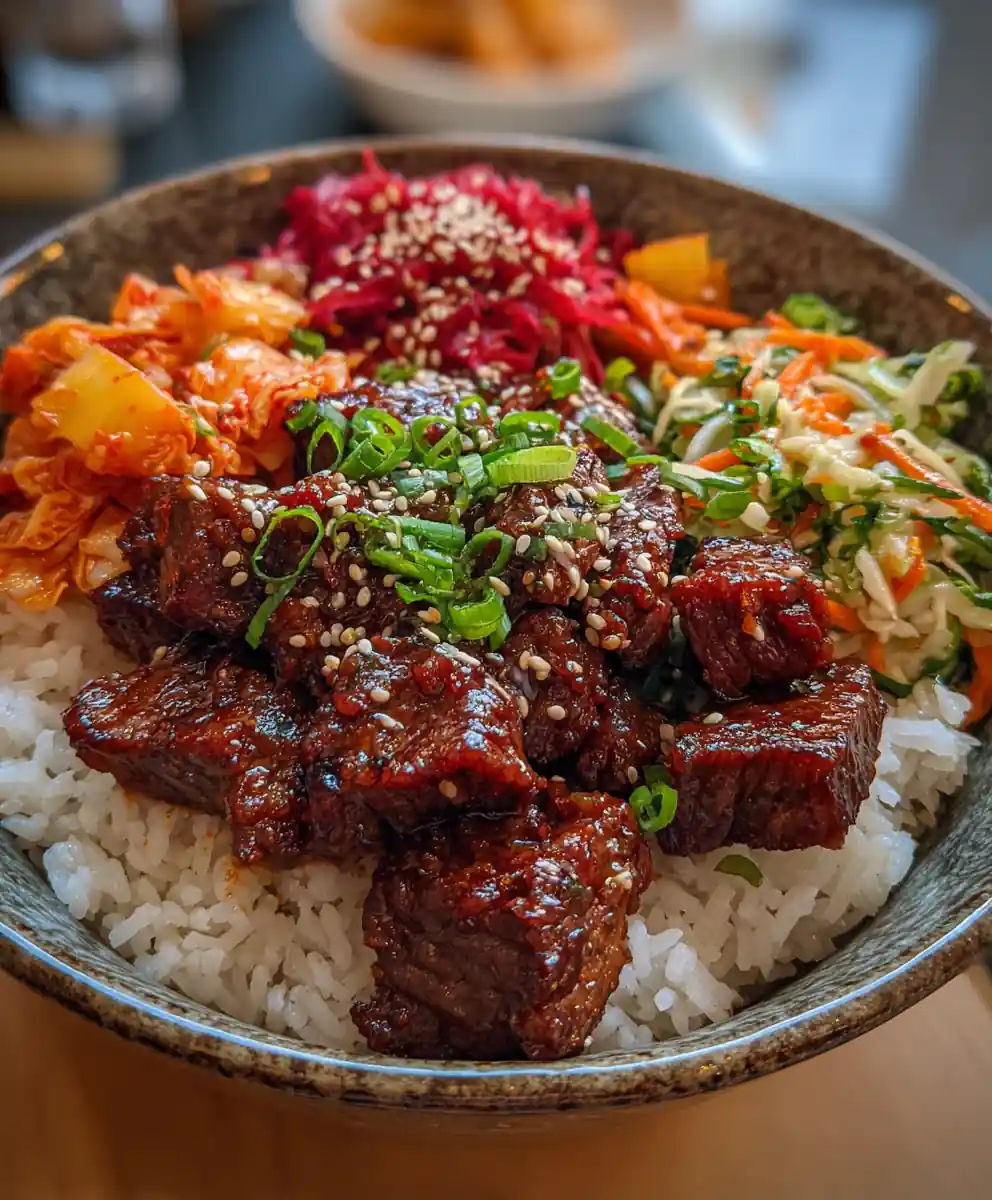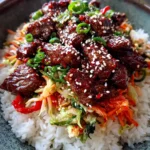I’ve found that a great Korean beef bowl recipe with Gochujang glaze and kimchi slaw can transform a hectic weeknight. Imagine the vibrant aroma of sweet and spicy beef caramelizing, promising a truly satisfying family dinner. This particular Korean beef bowl is an easy dinner idea, perfect for busy parents and home cooks craving big flavors without the fuss, offering a balanced, wholesome meal in under an hour.

Ingredient Essentials & Substitutions for Your Korean Beef Bowl
Crafting this flavorful korean beef bowl recipe relies on quality ingredients. Here’s what you’ll need:
Core Ingredients:
- Beef: 1 lb (450g) thinly sliced flank steak or sirloin (or ground beef if that’s quicker for your family).
- Gochujang Glaze: 1/4 cup (60ml) Gochujang, 2 tbsp (30ml) low-sodium soy sauce (or tamari for gluten-free needs), 1 tbsp (15ml) rice vinegar, 1 tbsp (15g) brown sugar (or honey), 1 tsp (5ml) sesame oil, 2 cloves minced garlic, 1 tsp grated fresh ginger.
- Kimchi Slaw: 2 cups (180g) shredded green cabbage, 1/2 cup (50g) shredded carrots, 1/4 cup (25g) chopped green onions, 1/2 cup (120g) prepared kimchi, 1 tbsp (15ml) rice vinegar, 1 tsp (5ml) sesame oil.
- Serving: Cooked medium-grain rice (white or brown), sesame seeds for garnish.
Health-Forward Upgrades:
- For a truly healthy Korean beef bowl, opt for organic grass-fed beef and low-sodium tamari.
- Swap brown rice for white, or use cauliflower rice for an easy low-carb meal with extra fiber.
Substitutions for Diets:
- Low-carb: Serve over cauliflower rice or crisp lettuce wraps.
- High-Protein: Boost protein by adding a cup of shelled edamame or extra beef.
- Dairy-free/Gluten-free: This recipe is naturally dairy-free; use tamari for a gluten-free korean beef bowl recipe.
- Vegetarian: Marinate firm tofu or tempeh in the Gochujang glaze and pan-fry.
Seasonal Shopping Notes:
For the freshest kimchi slaw, choose vibrant, crisp cabbage. It makes a significant difference in texture for this korean beef bowl recipe.
Step-by-Step Cooking Method for the Perfect Korean Beef Bowl
1. Prep Beef & Glaze (10 mins):
Thinly slice 1 lb of beef against the grain; aim for uniform pieces for even cooking. In a medium bowl, whisk together Gochujang, low-sodium soy sauce, rice vinegar, brown sugar, sesame oil, minced garlic, and grated ginger until smooth. This forms your fragrant Gochujang glaze. Toss half of the glaze mixture with the sliced beef until it’s evenly coated and glistening.
2. Make Kimchi Slaw (5 mins):
In a separate large bowl, combine shredded cabbage, carrots, chopped green onions, prepared kimchi, rice vinegar, and sesame oil. Mix gently with tongs until fully incorporated and the vegetables are lightly coated. Set aside for flavors to meld, developing a tangy aroma.
3. Cook Beef (5-7 mins):
Heat a 10-inch cast iron skillet or wok over medium-high heat until shimmering, about 2-3 minutes. Add the marinated beef in a single layer to avoid overcrowding. Cook quickly, turning until the edges are browned and the beef is cooked through, roughly 2-3 minutes per side. During the last minute, pour in the remaining Gochujang glaze, stirring until the beef is beautifully lacquered and glossy. If the beef starts to look dry, add a splash (1-2 tablespoons) of water or broth to create more sauce.
4. Assemble & Serve:
Serve the hot, glazed beef over a bed of fluffy cooked rice. Top generously with the fresh kimchi slaw and a sprinkle of sesame seeds for texture. This quick meal offers satisfying flavors.
Inline Swaps:
For a spicier kick in your Korean beef bowl recipe, add a pinch of red pepper flakes to the beef as it cooks. To make your slaw visually appealing, use a mix of purple and green cabbage for vibrant color.
Mini-Troubleshooting:
If your beef turns out tough, it’s often overcooked; cooking quickly at high heat is key. For a less watery slaw, I’ve found that lightly salting the shredded cabbage and letting it drain for 15 minutes before mixing works wonders.
Serving Ideas and Meal Contexts for Your Korean Beef Bowl
This vibrant Korean beef bowl is incredibly versatile, fitting perfectly into various mealtime scenarios. It’s a fantastic option for those seeking quick meals without sacrificing flavor.
- Best Moments: This dish is a lightning-fast weeknight dinner solution, impressive enough for a casual gathering with friends, and perfect for satisfying lunch meal prep throughout the week.
- Pairing Suggestions: Serve your bowl with extra steamed veggies like broccoli or snap peas, a simple side salad with a light vinaigrette, or a comforting light miso soup.
- Storage & Reheating: Store the cooked beef, kimchi slaw, and rice separately in airtight containers. Refrigerate for up to 3-4 days. For longer storage, the beef can be frozen for up to 2-3 months. Reheat beef gently in a pan or microwave; add a splash of water or broth to prevent drying. The slaw is best enjoyed fresh but will last a couple of days.
Lifestyle & Nutrition Gains from a Korean Beef Bowl with Gochujang Glaze and Kimchi Slaw
Embrace healthy eating with this Korean beef bowl, which offers a powerhouse of nutritional benefits for your family.
- Weight Support: Lean protein from the beef and fiber-rich vegetables in the slaw promote satiety, helping you feel fuller longer.
- Balanced Energy: Complex carbohydrates from rice provide sustained energy, while protein supports muscle health and overall vigor.
- Kid-Friendly Appeal: The customizable spice level of this dish makes it a flavorful family recipe that’s a hit with diverse palates, ensuring everyone enjoys their meal.
- High-Protein: An excellent source of high-quality protein, essential for muscle repair and maintenance.
- Gut Health Boost: Fermented kimchi is a key ingredient, supporting a healthy digestive system and contributing beneficial probiotics.
This recipe fits seamlessly into categories like easy healthy dinners, quick meal prep, and best high-protein meals, all while being naturally dairy-free.
Convenience & Budget Value of This Family-Friendly Meal
This dish shines as a family-friendly meal, balancing convenience with significant budget savings compared to takeout.
- Prep/Cook Time: Enjoy a complete, flavorful meal in a total time of under 40 minutes, perfect for busy weeknights.
- Cost Per Portion: Significantly more budget-friendly than restaurant takeout, you can leverage affordable beef cuts and pantry staples for this quick Korean beef bowl.
- Money-Saving Swaps: Maximize savings by buying beef on sale, opting for store-brand rice, and easily making your own slaw dressing from scratch.
- Batch Cooking & Meal Prep: This recipe is ideal for batch cooking. Easily double the recipe for multiple meals throughout the week and portion it into containers for convenient grab-and-go lunches.
Ingredient Shopping & Online Ordering for Your Korean Beef Bowl
Sourcing quality ingredients is key to a truly outstanding Korean beef bowl experience.
- Best Sources for Gochujang: This essential ingredient is readily available at local Asian markets, specialty grocery stores, or can be easily found and ordered online. For fresh beef and produce, most supermarkets will have what you need.
- Choosing Quality: Look for lean, fresh beef cuts for the best texture and flavor. Select vibrant, firm cabbage for a crisp, refreshing slaw. A good quality Gochujang truly makes a difference in the depth of the glaze.
- Specialty Substitutes: Health food stores are excellent sources for ingredients like gluten-free tamari or a wide range of organic options to elevate your dish.

Expert-Level Tips & Adjustments for Next-Level Flavor
Elevate your Korean beef bowl recipe with these vetted tricks and adjustments from our test kitchen.
- Advanced Tricks: For extra tender beef, marinate it for at least 30 minutes, or up to 4 hours for deeper flavor. Toasting sesame seeds for a few minutes in a dry skillet brings out an enhanced, nutty aroma. A dash of fish sauce in the Gochujang glaze can add an incredible layer of umami depth. I always toast my sesame seeds in a dry skillet for 2-3 minutes until fragrant; it truly enhances the aroma of the finished bowl.
- Adjustments: If you crave more heat, simply add an extra spoon of Gochujang or a pinch of Korean chili flakes. For a sweeter profile, a bit more brown sugar or honey in the glaze works wonders. A squeeze of fresh lime juice just before serving brightens the kimchi slaw beautifully.
- Allergy Swaps & Dietary Safety: For a soy allergy, readily substitute coconut aminos for soy sauce in the glaze. Always verify that your chosen Gochujang brand is certified gluten-free if needed for dietary safety.
FAQs about Korean Beef Bowls and Gochujang Glaze
Can this Korean beef bowl recipe be part of a healthy weight plan?
Yes, absolutely! This dish is rich in lean protein and nutrient-dense vegetables. To align it even more with a healthy weight plan, focus on portion control and opt for brown rice or cauliflower rice for added fiber.
What’s the best substitute for Gochujang in this recipe?
If Gochujang isn’t available, you can create a similar flavor profile by mixing sriracha, a touch of miso paste, and a pinch of sugar. Chili garlic sauce is another viable option, offering a good balance of heat and flavor.
Where can I buy fresh kimchi for the slaw?
Fresh kimchi is widely available at most Asian grocery stores, larger supermarkets with international aisles, and often from local farmers’ markets or health food stores. Look for it in the refrigerated section.
How long does this Korean beef bowl last in the fridge/freezer?
The cooked beef stores well in an airtight container in the fridge for 3-4 days. For longer storage, it can be frozen for up to 2-3 months. The kimchi slaw, while best fresh, will keep for 2-3 days refrigerated.
Can I make this Korean beef bowl recipe vegetarian or vegan?
Absolutely! For a delicious plant-based version, replace the beef with marinated and pan-fried firm tofu, tempeh, or even a hearty mix of sautéed mushrooms. Just ensure your Gochujang is vegan-friendly.
Is this Korean beef bowl recipe very spicy? How can I adjust the heat?
Gochujang offers a moderate, sweet heat. You can easily reduce the amount used in the glaze for a milder dish, or add more if you prefer extra spice. A little extra honey in the glaze can also help balance and temper the heat.
What kind of beef is best for a Korean beef bowl?
Thinly sliced flank steak, sirloin, or ribeye work wonderfully for this dish, offering great texture and flavor. Ground beef is also a popular and quick option for an easy family dinner. I find flank steak gives the best texture, but ground beef makes for an even quicker family dinner on busy nights.
Conclusion
This Korean beef bowl recipe with Gochujang glaze and kimchi slaw is your ultimate solution for easy, flavorful, and hearty home cooking. It’s a delicious way to bring exciting flavors and healthy eating to your family table any night of the week. For quick meals and family dinners, save this recipe to your Pinterest board!
Print
korean beef bowl recipe Gochujang Glaze With Kimchi Slaw
- Total Time: 35 minutes
- Yield: 4 servings 1x
- Diet: General
Description
This Korean beef bowl recipe features sweet and spicy Gochujang glazed beef served with a fresh kimchi slaw over rice, offering a flavorful and satisfying meal in under an hour.
Ingredients
- 1 lb (450 g) thinly sliced flank steak or sirloin, (or ground beef if that is quicker for your family)
- 0.25 cup (60 ml) Gochujang
- 2 tbsp (30 ml) low-sodium soy sauce (or tamari for gluten-free needs)
- 1 tbsp (15 ml) rice vinegar, for glaze
- 1 tbsp (15 g) brown sugar (or honey)
- 1 tsp (5 ml) sesame oil, for glaze
- 2 cloves minced garlic
- 1 tsp grated fresh ginger
- 2 cups (180 g) shredded green cabbage
- 0.5 cup (50 g) shredded carrots
- 0.25 cup (25 g) chopped green onions
- 0.5 cup (120 g) prepared kimchi
- 1 tbsp (15 ml) rice vinegar, for slaw
- 1 tsp (5 ml) sesame oil, for slaw
- Cooked medium-grain rice (white or brown), for serving
- Sesame seeds, for garnish
Instructions
- Prepare Beef and Glaze: Thinly slice 1 lb of beef against the grain for uniform pieces. In a medium bowl, whisk together 0.25 cup Gochujang, 2 tbsp low-sodium soy sauce, 1 tbsp rice vinegar, 1 tbsp brown sugar, 1 tsp sesame oil, 2 cloves minced garlic, and 1 tsp grated ginger until smooth. Toss half of this glaze mixture with the sliced beef until evenly coated.
- Make Kimchi Slaw: In a separate large bowl, combine 2 cups shredded cabbage, 0.5 cup shredded carrots, 0.25 cup chopped green onions, 0.5 cup prepared kimchi, 1 tbsp rice vinegar, and 1 tsp sesame oil. Mix gently with tongs until fully incorporated and lightly coated, then set aside.
- Cook Beef: Heat a 10-inch cast iron skillet or wok over medium-high heat until shimmering, about 2-3 minutes. Add the marinated beef in a single layer to avoid overcrowding. Cook quickly, turning until the edges are browned and the beef is cooked through, roughly 2-3 minutes per side. During the last minute, pour in the remaining Gochujang glaze, stirring until the beef is beautifully lacquered and glossy. (If the beef starts to look dry, add a splash (1-2 tablespoons) of water or broth to create more sauce.)
- Assemble and Serve: Serve the hot, glazed beef over a bed of fluffy cooked rice. Top generously with the fresh kimchi slaw and a sprinkle of sesame seeds for texture.
Notes
For a spicier kick, add a pinch of red pepper flakes to the beef as it cooks. To make your slaw visually appealing, use a mix of purple and green cabbage for vibrant color. If your beef turns out tough, it is often overcooked; cooking quickly at high heat is key. For a less watery slaw, lightly salt the shredded cabbage and let it drain for 15 minutes before mixing. Choose vibrant, crisp cabbage for the freshest kimchi slaw texture. Use tamari for gluten-free needs.
- Prep Time: 15 minutes
- Cook Time: 7 minutes
- Category: Main Course
- Method: Stovetop
- Cuisine: Korean
Nutrition
- Serving Size: 1 bowl (approx. 250 g)
- Calories: 550 calories
- Sugar: 18 g
- Sodium: 950 mg
- Fat: 25 g
- Saturated Fat: 10 g
- Unsaturated Fat: 12 g
- Trans Fat: 0 g
- Carbohydrates: 70 g
- Fiber: 6 g
- Protein: 28 g
- Cholesterol: 100 mg
